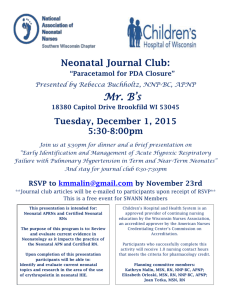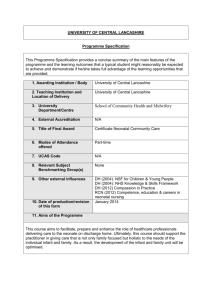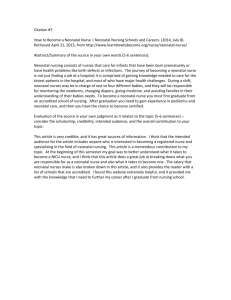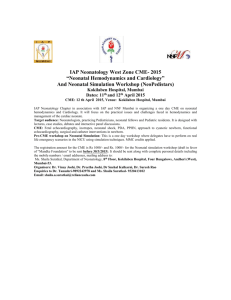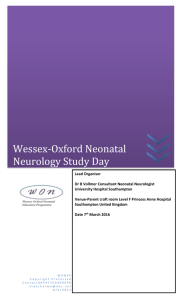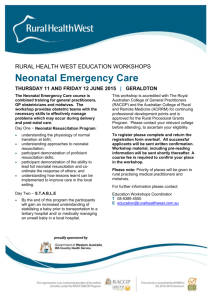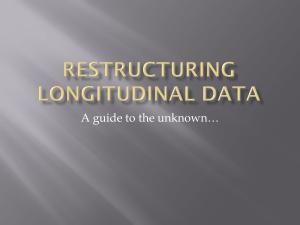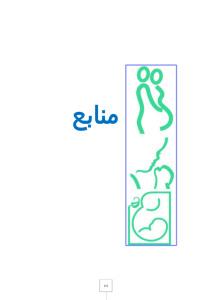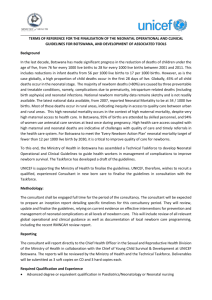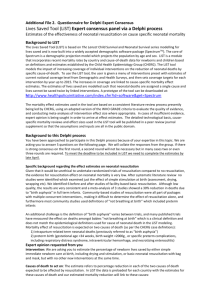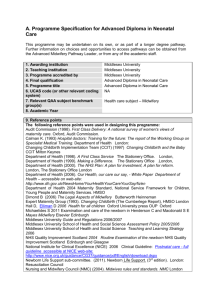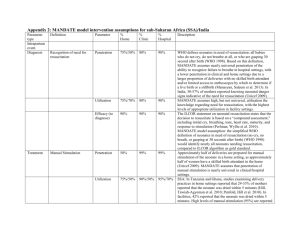Objectives
advertisement
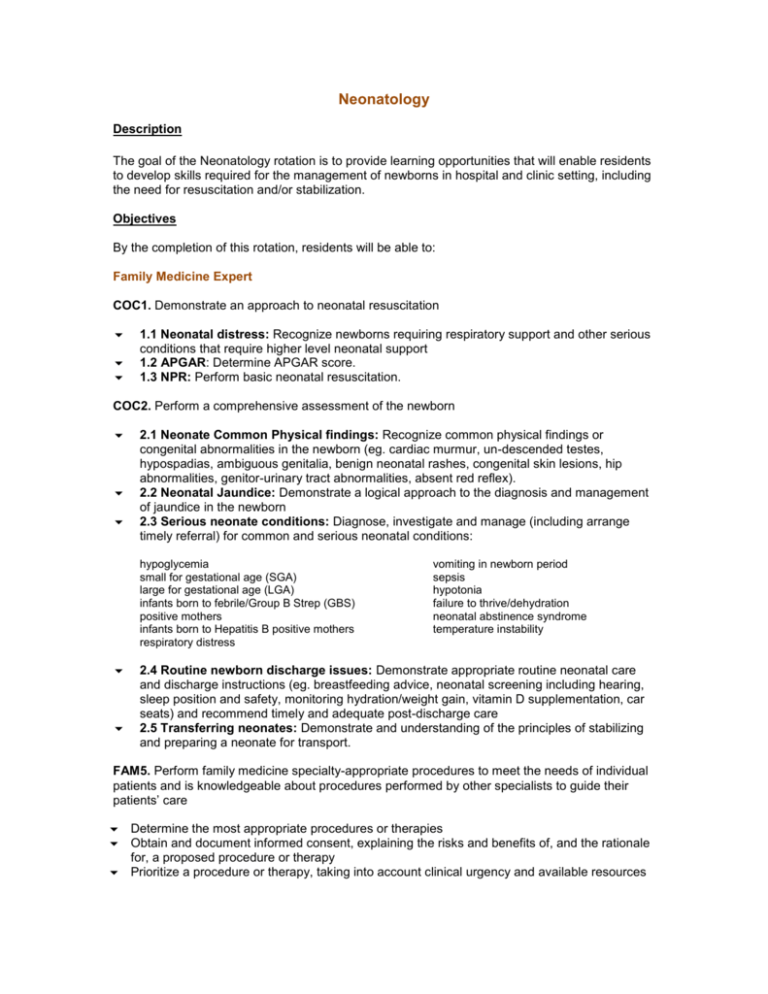
Neonatology Description The goal of the Neonatology rotation is to provide learning opportunities that will enable residents to develop skills required for the management of newborns in hospital and clinic setting, including the need for resuscitation and/or stabilization. Objectives By the completion of this rotation, residents will be able to: Family Medicine Expert COC1. Demonstrate an approach to neonatal resuscitation 1.1 Neonatal distress: Recognize newborns requiring respiratory support and other serious conditions that require higher level neonatal support 1.2 APGAR: Determine APGAR score. 1.3 NPR: Perform basic neonatal resuscitation. COC2. Perform a comprehensive assessment of the newborn 2.1 Neonate Common Physical findings: Recognize common physical findings or congenital abnormalities in the newborn (eg. cardiac murmur, un-descended testes, hypospadias, ambiguous genitalia, benign neonatal rashes, congenital skin lesions, hip abnormalities, genitor-urinary tract abnormalities, absent red reflex). 2.2 Neonatal Jaundice: Demonstrate a logical approach to the diagnosis and management of jaundice in the newborn 2.3 Serious neonate conditions: Diagnose, investigate and manage (including arrange timely referral) for common and serious neonatal conditions: hypoglycemia small for gestational age (SGA) large for gestational age (LGA) infants born to febrile/Group B Strep (GBS) positive mothers infants born to Hepatitis B positive mothers respiratory distress vomiting in newborn period sepsis hypotonia failure to thrive/dehydration neonatal abstinence syndrome temperature instability 2.4 Routine newborn discharge issues: Demonstrate appropriate routine neonatal care and discharge instructions (eg. breastfeeding advice, neonatal screening including hearing, sleep position and safety, monitoring hydration/weight gain, vitamin D supplementation, car seats) and recommend timely and adequate post-discharge care 2.5 Transferring neonates: Demonstrate and understanding of the principles of stabilizing and preparing a neonate for transport. FAM5. Perform family medicine specialty-appropriate procedures to meet the needs of individual patients and is knowledgeable about procedures performed by other specialists to guide their patients’ care Determine the most appropriate procedures or therapies Obtain and document informed consent, explaining the risks and benefits of, and the rationale for, a proposed procedure or therapy Prioritize a procedure or therapy, taking into account clinical urgency and available resources Perform the following procedures in a skillful and safe manner, adapting to unanticipated findings of changing clinical circumstances: Neonatal resuscitation Blood drawing Peripheral arterial puncture Peripheral IV catheter placement Umbilical vein/artery catheterization Peripheral arterial catheterization Endotracheal intubation Lumbar puncture Paracentesis/Thoracentesis Suprapubic aspiration of the bladder Bladder catheritization Orogastric/nasogastric tube placement Communicator FAM8. Establish effective professional relationships with patients and their families 8.1 Patient centered approach: Communicate using a patient-centered approach that encourages patient trust and autonomy and is characterized by empathy, respect, and compassion 8.2 Environment: Optimize the physical environment for patient comfort, dignity, privacy, engagement, and safety 8.3 Patient perspectives: Recognize when the values, biases, or perspectives of patients, physicians, or other health care professionals may have an impact on the quality of care, and modify the approach to the patient accordingly 8.4 Non-verbal communication: Respond to a patient’s non-verbal behaviors to enhance communication 8.5 Disagreements: Manage disagreements and emotionally charged conversations 8.6 Adapting communication: Adapt to the unique preferences of each patient and to his or her clinical condition and circumstances. o Children: Adapt communication methods based on the age of the child. FAM9. Elicit and synthesize accurate and relevant information, incorporating the perspectives of patients and their families 9.1 Patient-centered interviewing: Use patient-centered interviewing skills to effectively gather relevant biomedical and psychosocial information 9.2 Structure of interview: Provide a clear structure for and manage the flow of an entire patient encounter 9.3 Corroborating information: Seek and synthesize relevant information from other sources, including the patient’s family or caregivers, with the patient’s consent FAM10. Share health care information and plans with patients and their families 10.1 Sharing information: Share information and explanations that are clear, accurate, and timely, while checking for patient and family understanding 10.2 Disclosure: Disclose harmful patient safety incidents to patients and their families accurately and appropriately FAM11. Engage patients and their families in developing plans that reflect the patient’s health care needs and goals 11.1 Cultural safety: Facilitate discussions with patients and their families in a way that is respectful, non-judgmental, and culturally safe 11.2 Support decision-making: Assist patients and their families to identify, access, and make use of information and communication technologies to support their care and manage their health 11.3 Common ground: Use communication skills and strategies that help patients and their families make informed decisions leading to a shared plan of care. FAM12. Document and share written and electronic information about the medical encounter to optimize clinical decision-making, patient safety, confidentiality, and privacy 12.1 Documentation requirements: Document clinical encounters in an accurate, complete, timely, and accessible manner, in compliance with regulatory and legal requirements 12.2 Record format: Communicate effectively using a written health record, electronic medical record, or other digital technology 12.3 Information sharing: Share information with patients and others in a manner that respects patient privacy and confidentiality and enhances understanding Communicator FAM11. Engage patients and their families in developing plans that reflect the patient’s health care needs and goals 11.1 Cultural safety: Facilitate discussions with patients and their families in a way that is respectful, non-judgmental, and culturally safe 11.2 Support decision-making: Assist patients and their families to identify, access, and make use of information and communication technologies to support their care and manage their health 11.3 Common ground: Use communication skills and strategies that help patients and their families make informed decisions leading to a shared plan of care. FAM12. Document and share written and electronic information about the medical encounter to optimize clinical decision-making, patient safety, confidentiality, and privacy 12.1 Documentation requirements: Document clinical encounters in an accurate, complete, timely, and accessible manner, in compliance with regulatory and legal requirements 12.2 Record format: Communicate effectively using a written health record, electronic medical record, or other digital technology 12.3 Information sharing: Share information with patients and others in a manner that respects patient privacy and confidentiality and enhances understanding Collaborator FAM13. Work effectively with physicians and other colleagues in the health care professions 13.1 Relationship: Establish and maintain positive relationships with physicians and other colleagues in the health care professions to support relationship-centered collaborative care 13.2 Team communication: Demonstrate clear and effective communication (both written and verbal) with physicians and other colleagues in the healthcare professions. 13.3 Shared decision-making: Negotiate overlapping and shared responsibilities with physicians and other colleagues in the health care professions. 13.4 Positive work environment: Implement strategies to promote understanding, manage differences, and resolve conflicts in a manner that supports a collaborative culture FAM14. Hand over the care of a patient to another health care professional to facilitate continuity of safe patient care 14.1 Timing of transfers: Determine when care should be transferred to another physician or health care professional 14.2 Safe transfers: Demonstrate safe handover of care, using both verbal and written communication, during a patient transition to a different health care professional, setting, or stage of care Leader/Manager FAM20. Engage in the stewardship of health care resources 20.1 Resource allocation: Allocate health care resources for optimal patient care, including referral to other health care professionals and community resources 20.2 Cost appropriate care: Apply evidence and management processes to achieve costappropriate care Health Advocate FAM21. Respond to an individual patient’s health needs by advocating with the patient within and beyond the clinical environment 21.1 Determinants of health: Work with patients to address determinants of health that affect them and their access to needed health services or resources Scholar FAM24. Integrate best available evidence, contextualized to specific situations, into real-time decision-making 24.1 Identifying knowledge gap: Recognize practice uncertainty and knowledge gaps in clinical encounters and generate focused questions that can address them. 24.4 Integrating evidence: Integrate evidence into decision-making in their practice by reviewing and appropriately applying guidelines from organizations such as Health Canada, the College of Family Physicians of Canada, and the Canadian Pediatric Society. Professional FAM27. Demonstrate a commitment to patients 27.1 Professional behaviors: Exhibit appropriate professional behaviors and relationship in all aspects of professional practice, reflecting honesty, integrity, commitment, compassion, respect, altruism, respect for diversity, and for maintenance of confidentiality. 27.2 Excellence: Demonstrate a commitment to excellence in all aspects of practice. 27.3 Ethical issues: Recognize and respond to ethical issues encountered in practice. Entrustable Professional Activities Provide family medicine centered care to newborns in their first weeks of life. Evaluation Field Notes In-training Assessment Report (ITAR)
